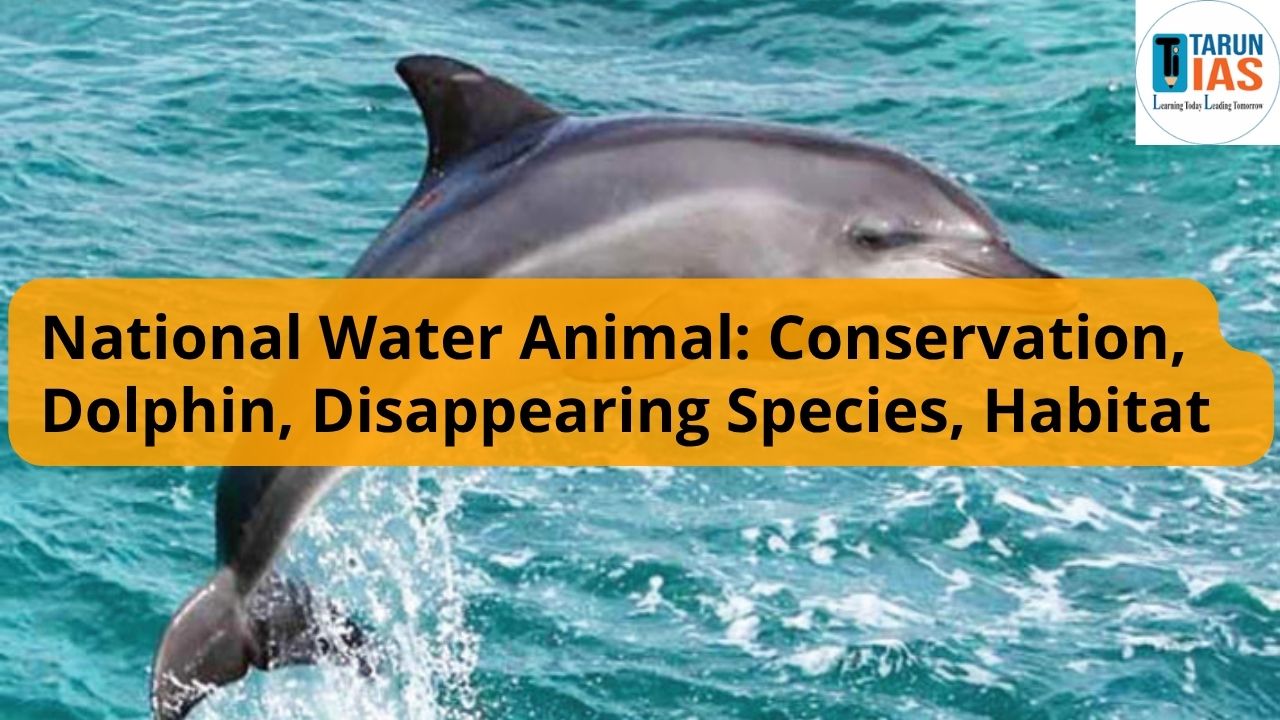India is a land of rich biodiversity, and to recognize and conserve its unique aquatic heritage, the Government of India declared the Ganges River Dolphin as the National Water Animal in 2009. This step was aimed at creating awareness and providing legal and institutional protection to a species that is a key indicator of the health of the Ganga river system. This gentle, freshwater creature is also the State Aquatic Animal of Assam.
National Water Animal Background

On 5th October 2009, the government declared the river dolphin as India’s National Water Animal to protect our rivers.
- The Ganges River Dolphin was first discovered in 1801 by William Roxburgh.
- The species inhabits the Ganga-Brahmaputra-Meghna and Karnaphuli-Sangu river systems in India, Nepal, and Bangladesh.
- It was officially declared the National Water Animal by the Indian government during the first meeting of the National Ganga River Basin Authority (NGRBA) held in 2009.
The main motive behind this declaration was to protect the dolphin from the threat of extinction and to symbolize the ecological health of India’s river systems, especially the Ganges.
Why Was the Ganges River Dolphin Chosen?
The Ganges River Dolphin was declared India’s National Water Animal due to its endangered status, ecological importance, cultural value, and role as a vital indicator of riverine health.
- Endangered Status: Listed as Endangered by the IUCN since 1998 due to drastic decline in population.
- Ecological Indicator: It is a key species that reflects the health of the freshwater ecosystem.
- Unique Freshwater Mammal: It is one of the few river dolphins in the world.
- National and Cultural Significance: Revered in folklore and literature, its conservation is crucial for ecological and cultural reasons.
- Alarmingly Low Population: The population is now restricted to small pockets due to anthropogenic stress, pollution, and overfishing.
Physical Features of the Gangetic Dolphin
The Gangetic Dolphin has a sturdy, flexible body with a long pointed snout, small dorsal fin, and no functional eyes. It uses echolocation to navigate and hunt in muddy rivers.
| Feature | Description |
| Scientific Name | Platanista gangetica |
| Common Names | Susu, Hihu, Blind Dolphin, Side-swimming Dolphin |
| Weight | 150–170 kg (Male), Up to 200 kg (Female) |
| Length | 2.12 m (Male), 2.67 m (Female) |
| Snout | Long and pointed with thickened tip |
| Eyes | No lens; functionally blind |
| Color | Chocolate brown at birth; greyish-brown in adulthood |
| Fin | Undeveloped, low triangular dorsal fin |
| Body | Stocky, rounded belly, flexible body, large flippers |
National Aquatic Animal Unique Adaptations
The Gangetic Dolphin adapts using echolocation, surfaces regularly to breathe, feeds by rooting riverbeds, swims sideways, and gives birth to a single calf every 2–3 years.
- Blind but not helpless: Uses echolocation to locate prey in murky waters.
- Breathing: Being a mammal, it must surface every 30 to 120 seconds to breathe.
- Feeding: Feeds on fish, shrimp, and other invertebrates by rooting in riverbeds with its beak.
- Side-swimming: Uniquely swims on its side.
- Reproduction:
- Gestation: 9 to 11 months
- Calving Interval: Once every 2-3 years
- Calf Born: One at a time
National Water Animal Distribution and Habitat
The Gangetic Dolphin inhabits deep, slow-flowing rivers across India, Nepal, and Bangladesh, mainly in the Ganga basin, and avoids shallow, fast-moving, or heavily dammed river stretches.
The Gangetic Dolphin inhabits
- India: Stretching from Narora (U.P.) to Sundarbans (West Bengal)
- Nepal: Major rivers in the Terai region
- Bangladesh: Ganga-Meghna delta and surrounding river systems
In India, dolphins are now mainly found in
- Ganga River
- Chambal River
- Ghaghra River
- Gandak River
- Brahmaputra River
- Kosi and Son Rivers
They are restricted to creeks, oxbow lakes, and deep river channels, avoiding fast-flowing, shallow, or heavily dammed sections.
National Water Animal Major issues
Gangetic Dolphins face issues from polluted waters, disrupted migration due to dams, overfishing, poaching, habitat loss from sand mining, and noise pollution that hampers their echolocation abilities.
- Pollution: Industrial effluents, plastic waste, and sewage make the water toxic.
- Dams and Barrages: Interrupt migration and breeding.
- Overfishing: Depletes food resources and causes accidental entanglement in nets.
- Habitat Degradation: Sand mining and riverbed modification impact their natural habitat.
- Poaching: For oil and meat, though banned.
- Noise Pollution: Boat motors and industrial activities interfere with echolocation.
Aquatic Animal of India Conservation Efforts
India’s conservation efforts include Project Dolphin, NMCG, protected sanctuaries, and scientific research to protect habitats, raise awareness, and ensure survival of both river and ocean dolphins across ecosystems.
Project Dolphin 2020
- Launched by PM Narendra Modi
- Modeled on Project Tiger
- Focused on both river and ocean dolphins
- Aims at protecting, monitoring, and restoring dolphin populations
National Ganga River Basin Authority (NGRBA)
- Declared dolphin as the National Water Animal
- Integrated conservation of Ganga ecosystem
National Mission for Clean Ganga (NMCG)
- Works toward cleaning Ganga and supporting dolphin habitat restoration
Protected Areas
- Vikramshila Gangetic Dolphin Sanctuary, Bihar
- Chambal River Sanctuary
Scientific Research and Awareness
- Census of dolphins in Ganga by Wildlife Institute of India (WII)
- Eco-sensitive awareness programs in schools and riverside communities
Recent Census 2024 of National Water Animal
According to the first-ever nationwide survey conducted by WII:
- Population found: 6,327 Gangetic Dolphins
- Found across Ganga, Yamuna, Chambal, Ghagra, Gandak, and Son rivers
This number is a slight increase from previous estimates (2,000-3,000), indicating slow but positive signs of conservation efforts.
National Water Animal Importance of Conservation
Conservation of the Gangetic dolphin ensures ecological balance, indicates healthy rivers, provides scientific insights, preserves cultural heritage, and promotes sustainable development while benefiting both aquatic life and human communities.
- Ecological Balance
-
-
- Being apex predators, dolphins help maintain healthy fish populations.
-
- Bio-indicator
-
-
- Presence of dolphins means a clean, well-oxygenated river.
-
- Scientific Value
-
-
- Understanding echolocation and aquatic adaptations.
-
- Cultural Heritage
-
-
- Revered in local folklore; presence enhances natural heritage.
-
- Sustainable Development
-
- Clean rivers support not just dolphins, but humans too.
National Aquatic Animal Way Forward
To protect Gangetic dolphins, we must follow all the things.
- Community Involvement
- Engage local fishermen in conservation programs
- Eco-tourism:
- Develop responsible dolphin-watching programs
- Education and Awareness
- Incorporate environmental studies in school curriculum
- Strengthen Law Enforcement
- Strict penalties for pollution, poaching, and illegal fishing
- Scientific Research
- Support more studies on behavior, reproduction, and genetics
- Cross-border Cooperation
- Joint initiatives with Nepal and Bangladesh for conservation
Conclusion
The Ganges River Dolphin is more than just a species; it is a living symbol of the health and purity of our rivers. As the National Water Animal of India, its conservation is not just about saving a species, but about protecting a whole freshwater ecosystem. While recent surveys give hope, the road ahead requires continuous effort, public participation, and government commitment.















